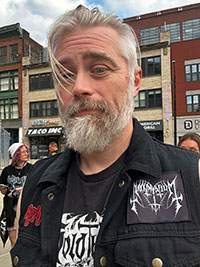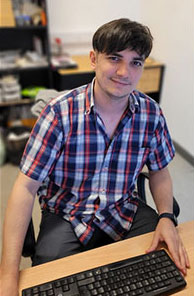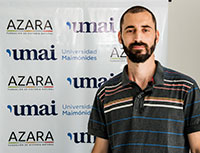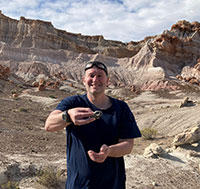 John A. Whitlock. Department of Science and Mathematics, Mount Aloysius College, Cresson, Pennsylvania 16630, U.S.A. and Section of Vertebrate Paleontology, Carnegie Museum of Natural History, Pittsburgh, Pennsylvania 15213, U.S.A. jwhitlock@mtaloy.edu
John A. Whitlock. Department of Science and Mathematics, Mount Aloysius College, Cresson, Pennsylvania 16630, U.S.A. and Section of Vertebrate Paleontology, Carnegie Museum of Natural History, Pittsburgh, Pennsylvania 15213, U.S.A. jwhitlock@mtaloy.edu
John Whitlock is an Associate Professor of Organismal Biology at Mount Aloysius College and a Research Associate at Carnegie Museum of Natural History in the Section of Vertebrate Paleontology. He also serves as an Associate Editor for Historical Biology. He studies the systematics and ecology of dinosaurs, specializing on sauropods. His most recent work has revolved around the cranial anatomy of dicraeosaurid sauropods of North and South America.
![]()
 Juan Pablo Garderes. CONICET Consejo Nacional de Investigaciones Científicas y Técnicas, Ciudad Autónoma de Buenos Aires, Argentina and Fundación de Historia Natural Félix de Azara, Centro de Ciencias Naturales, Ambientales y Antropológicas, Universidad Maimónides, Hidalgo, Argentina. garderes.juanpablo@maimonides.edu
Juan Pablo Garderes. CONICET Consejo Nacional de Investigaciones Científicas y Técnicas, Ciudad Autónoma de Buenos Aires, Argentina and Fundación de Historia Natural Félix de Azara, Centro de Ciencias Naturales, Ambientales y Antropológicas, Universidad Maimónides, Hidalgo, Argentina. garderes.juanpablo@maimonides.edu
Dr J. P. Garderes is a Post-Doctoral Fellowship grantee (CONICET) working at the Centro de Ciencias Naturales, Ambientales y Antropológicas, Universidad Maimónides (CCNAA-UMAI, Argentina). His expertise is in sauropod palaeobiology, 3-D imaging, and biomechanics. His research is primarily focused on the palaeobiological aspects related to the crania of diplodocoid taxa (Garderes, 2025; Garderes et al., 2023), mostly on the biomechanical, palaeoecological, and palaeoneurological (Garderes et al., 2022) aspects. He has been also involved in the systematics and modelling of non-archosaur taxa (Muzzopappa et al., 2020). Throughout his doctoral research, he acquired skills in programming in order to solve methodological crossroads –related to computational or software-availability issues– such as developing a novel methodological approach for biomechanical analyses in R, as well as a vast experience in 3-D imaging on both soft-tissue and osseous elements.
![]()
 Pablo Gallina. CONICET Consejo Nacional de Investigaciones Científicas y Técnicas, Ciudad Autónoma de Buenos Aires, Argentina and Fundación de Historia Natural Félix de Azara, Centro de Ciencias Naturales, Ambientales y Antropológicas, Universidad Maimónides, Hidalgo, Argentina. gallina.pablo@maimonides.edu
Pablo Gallina. CONICET Consejo Nacional de Investigaciones Científicas y Técnicas, Ciudad Autónoma de Buenos Aires, Argentina and Fundación de Historia Natural Félix de Azara, Centro de Ciencias Naturales, Ambientales y Antropológicas, Universidad Maimónides, Hidalgo, Argentina. gallina.pablo@maimonides.edu
Dr P. Gallina is a “Investigador Adjunto” (CONICET) working at the Centro de Ciencias Naturales, Ambientales y Antropológicas, Universidad Maimónides (CCNAA-UMAI, Argentina). His expertise is in Systematics and Palaeobiology of Sauropoda, with several publications focused in both Macronaria (e.g., Gallina & Apesteguía, 2011; Gallina et al., 2021) and Diplodocoidea (e.g., Gallina & Apesteguía, 2005; Gallina et al., 2014, 2019; Gallina, 2016). He has also been part of several studies focused in non-sauropod palaeontology, such as in Theropoda (Canale et al., 2017, 2022). As a Director, he lead the Centro de Ciencias Naturales, Ambientales y Antropológicas at the Universidad Maimónides (CCNAA-UMAI, 2020-2022). He has conducted or participated in several fieldworks, primarily in Argentina, but also in Bolivia, and Hungary.
![]()
 Matthew C. Lamanna. Section of Vertebrate Paleontology, Carnegie Museum of Natural History, Pittsburgh, Pennsylvania 15213, U.S.A.: lamannam@carnegiemnh.org
Matthew C. Lamanna. Section of Vertebrate Paleontology, Carnegie Museum of Natural History, Pittsburgh, Pennsylvania 15213, U.S.A.: lamannam@carnegiemnh.org
Matt Lamanna is the Mary R. Dawson Curator of Vertebrate Paleontology and the principal dinosaur researcher at Carnegie Museum of Natural History in Pittsburgh, Pennsylvania, USA. Originally from the Finger Lakes region of New York State, he received his B.Sc. from Hobart College in 1997 and his M.Sc. and Ph.D. from the University of Pennsylvania in 1999 and 2004, respectively. Within the past 27 years, he has directed or co-directed field expeditions to Antarctica, Argentina, Australia, China, Croatia, Egypt, and Greenland that have resulted in the discovery of more than 20 new species of dinosaurs and other fossil animals from the Cretaceous Period, the third and final time period of the Age of Dinosaurs; indeed, he is one of only a handful of people in history to have found dinosaur fossils on all seven continents. Lamanna served as chief scientific advisor to Carnegie Museum of Natural History’s $36M Daniel G. and Carole L. Kamin Hall of Dinosaurs and has appeared on television programs for PBS (NOVA), the Discovery Channel, the National Geographic Channel, the History Channel, A&E, the Science Channel, and more.

